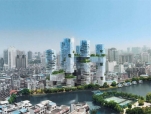The Vector of Development

Economic upsurge of China has led to increased mobility of the population and its concentration in large cities, and this, in turn, requires a substantial increase in residential construction.
Thus there is a need to create model projects that would help the government to solve urgent problem of housing to satisfy demand of the growing urban population. Practice shows that in this situation the most suitable option can turn a complex development of territories. Just such a project was developed at the request of the authorities of the city of Wuhan by the Denmark-based JDS Architects. The complex of buildings was named Wuhan Mikado. Wuhan is the capital of Hubei province, People’s Republic of China, and is the most populous city in Central China. It lies at the east of the Jianghan Plain, and the intersection of the middle reaches of the Yangtze and Han rivers.
Arising out of the conglomeration of three cities, Wuchang, Hankou, and Hanyang, Wuhan is known as “the nine provinces’ leading thoroughfare”; it is a major transportation hub, with dozens of railways, roads and expressways passing through the city. The consolidation of these three cities occurred in 1927 and Wuhan was thereby established. These three parts face each other across the rivers and are linked by bridges, including one of the first modern bridges in China, known as the “First Bridge”. It is simple in geographical structure – low and flat in the middle and hilly in the south, with the Yangtze and Han rivers winding through the city.
Wuhan occupies a land area of 8,494.41 square kilometres (3,279.71 sq mi), most of which is plain and decorated with hills and a great number of lakes and pools. Because of its key role in domestic transportation, Wuhan was sometimes referred to as the “Chicago of China.” It is recognized as the political, economic, financial, cultural, and transportation center of central China. Wuhan is one of the three scientific and educational centers of China, along with Beijing and Shanghai. The city of Wuhan has 85 higher educational institutions such as Wuhan University and Huazhong University of Science and Technology.
It also contains three national development zones and four scientific and technologic development parks, as well as numerous enterprise incubators, over 350 research institutes, 1470 hi-tech enterprises, and over 400,000 experts and technicians. Wuhan also boasts eight national colleges and universities among its 36 colleges and universities. The city of Wuhan, first termed as such in 1927, has a population of 10,020,000 people (as at 2011), with about 6,434,373 residents in its urban area.
Full version you can download here
 Materials provided by JDS Architects
Materials provided by JDS Architects


